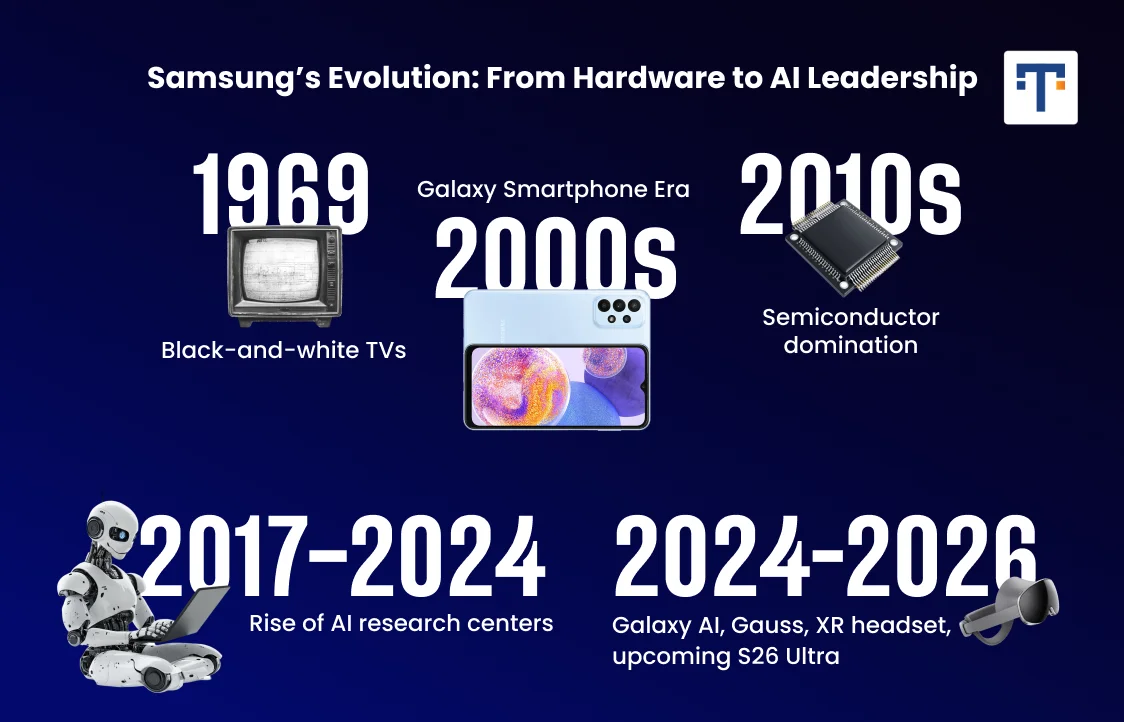Necessary Always Active
Necessary cookies are required to enable the basic features of this site, such as providing secure log-in or adjusting your consent preferences. These cookies do not store any personally identifiable data.
|
||||||
|
||||||
|
||||||
|

The brand name “Samsung” is already a household name for hardware engineering, especially for its semiconductors and smartphones with a sleek user interface. From entering the electronics market with black-and-white TVs in 1969 to launching the Samsung Galaxy Series in the 2000s, the company is now shifting focus to become an AI powerhouse.
The current wave of artificial intelligence applications in our everyday activities creates an opportunity gap for companies with the investment power to lead. This brings about Samsung AI innovation, as we discuss the steps the hardware manufacturer is taking to become a top AI-powered intelligence solution.
Samsung’s AI innovation shift can be explained by a series of strategic investments and the company’s multifaceted approach. The organizational transformation in recent years has been achieved through some of the following:
Samsung has created a network of AI research facilities across major technology hubs. For example, Samsung is partnering with NVIDIA on an AI megafactory that will deploy over 50,000 NVIDIA GPUs. Its different centers, operating in regions like Seoul, Silicon Valley, Moscow, and Toronto, are focused on specific areas such as deep learning and natural language processing, to computer vision and robotics. It is a strategy to tap into regional expertise through collaborative in-house efforts across borders.
Samsung AI chip development heavily leverages its expertise in semiconductor technologies, such as its Exynos processors. These Exynos chips integrated with neural processing units (NPUs) enable robust on-device AI processing while reducing latency by locally storing sensitive data instead of using cloud computing servers. Unlike some other hardware companies, Samsung’s ability to manufacture its own AI chip processors is a competitive advantage for its AI development program.
Samsung AI technology advancement greatly benefits from its unique position as both a hardware manufacturer and software developer. This creates a vertical integration advantage since Samsung controls the entire manufacturing stack from silicon fabrication to device assembly to application development. Competitors with fragmented supply chains may struggle to match the seamless flow from hardware capabilities to operating system features.
Analysis of the growth map of Samsung AI innovation is a trend that explains how the company has successfully embedded intelligence in the majority of its product ecosystem, such as:
Samsung’s on-device AI capabilities integrated into Exynos System-on-Chips allow AI models to run on its devices without the constant need for cloud services. This means artificial intelligence interactions on your Samsung device while keeping personal data safe from online breaches. The quantization technologies to run on-device despite limited computing resources and memory capacity are a big achievement.
Applications in the latest AI-powered Samsung phones include live translation, generative edits of unwanted objects in backgrounds, or even enhancing image quality with a single click. Advanced capabilities, such as deep search or knowledge retrieval, may require cloud services.
Artificial intelligence technologies are to improve how we do things and live our lives. That is what Samsung AI’s innovative strategies are all about, especially through the SmartThings ecosystem.
SmartThings refers to the central nervous system for Samsung’s connected devices, such as TVs, refrigerators, washing machines, and other home appliances. For example, your Samsung TV can connect to your Galaxy watch and be controlled by simple hand gestures. It can also recommend picture settings based on the lighting conditions in your home.

There are also smart Samsung refrigerators that track what is inside them using AI vision and suggest recipes based on tracked dietary preferences. Samsung is building an adaptive and connected living environment where devices work intelligently to serve user needs.
Samsung AI innovation is not complete without discussing the role of the Samsung Gauss model. With distinct generative features such as language, image, and code, the Samsung Gauss system is the core generative model behind the company’s artificial general intelligence capabilities.
These include text generation, language translation with contextual understanding, image creation and editing, and code writing to automate tasks. Samsung uses Gauss internally and alongside partner models; its Gauss family is part of Samsung’s strategy to reduce reliance on third parties.
Samsung’s investment approach focuses on the future of artificial intelligence and sustained capabilities, and not just short-term spending. For example, Samsung C&T and Vietnam’s CMC Corporation are planning a $1.3 billion data center hub project with a 30 MW and another 100 MW facility in Ho Chi Minh City.
This move by one of Samsung’s companies explains its commitment to advanced AI infrastructures and research & development in machine learning algorithms. As a global brand transitioning to AI-powered solutions, the investment method supports its competitive strategy.
Samsung’s role in the global AI race is met with strict competition, such as the Samsung Galaxy AI vs Apple Intelligence in neural engines and privacy-focused AI generative models. Some other notable mentions are Huawei, from telecom hardware to smart ecosystems, and Xiaomi, from smartphone manufacturing to AIoT ecosystems. Here is a summary of Samsung’s genius approach to the global competition:
Capitalizing on one’s greatest strength is crucial to moving up the ranks in a heavily contested AI and machine learning field. This is what Samsung is doing as one of the world’s largest semiconductor manufacturers, compared to some of its competitors still negotiating with chip suppliers.
Samsung manufactures its own mobile Exynos chips with next-generation technologies featuring high-bandwidth memory and advanced DRAM essential for AI workloads. Its innovative processor design and memory architecture was instrumental in securing the recent $16.5 billion chip agreement with Tesla. As confirmed by Elon Musk, Samsung is expected to play a major role in the manufacture and supply of semiconductors to Tesla over the coming years.
Through Samsung Next, the company has invested in numerous AI-focused startups across diverse domains, including computer vision, natural language processing, robotics, and edge AI. Samsung’s strategic investments, such as launching its Galaxy S25 with Google’s AI model and Qualcomm chips, are helping it compete with rivals like Huawei and Apple.
These kinds of partnership deals have been instrumental in Samsung AI’s transformation from a hardware company to AI leadership. The company is also intensifying its global talent recruitment efforts to attract the best engineering and research minds.
Samsung’s AI innovation journey explains the balance of investment and strategic vision. The company has made progress with recent releases, such as the Galaxy S25 series and the Samsung Galaxy XR headset. Looking ahead to 2026, Samsung users are expecting the launch of the highly anticipated Galaxy S26 Ultra. We can also expect upgrades to Ballie – Samsung’s home robot, after the partnership with Google Cloud to use Gemini multimodal capabilities.
Sign up to receive our newsletter featuring the latest tech trends, in-depth articles, and exclusive insights. Stay ahead of the curve!